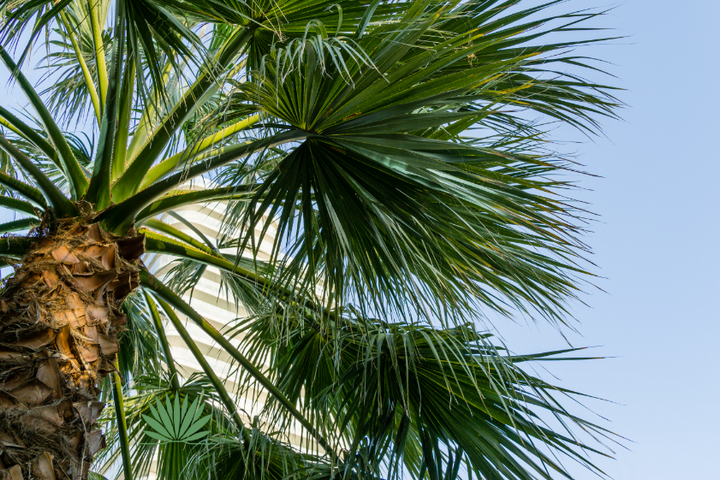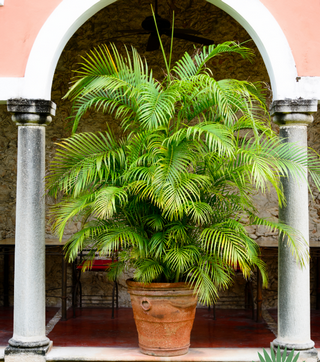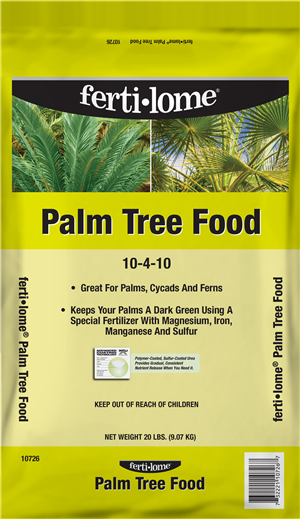How and when should you fertilize desert landscape palms? Do you really need a special palm fertilizer? Discover why fertilizing is recommended, what to look for in a palm fertilizer, and the best times to fertilize your palms.

While very few palms are native to the southwest, palms have a beloved place in desert landscaping. They definitely give off a tropical, relaxing vibe and offer some unique benefits. They take up little space and are low litter, and provide habitat for wildlife.
Whether you’ve got one palm or several, you may be unsure of how to feed them. Let’s take a look at why fertilizer is needed, what to look for in a palm fertilizer, and how and when to fertilize.
Why Fertilizer Palms?
Nearly all landscape palms originate outside the desert southwest, and so have not evolved to make the best use of the nutrients in desert soil. (Alkaline desert soil binds up nutrients, making them unavailable to plants.)
Compared to palms growing in the wild, landscape palms face additional stressors, and so benefit from extra TLC. They are planted next to the reflected heat of walls, patios, and pools. We remove their dried fronds, which protects them from the sun and helps keep their trunks and roots cool. They are often watered improperly — too much water can lead to nutrient deficiencies.
Fertilizing palms will help them overcome these stressors. The right nutrients can help keep them healthy and less susceptible to diseases and pests.
Fertilizing can prevent deficiencies before they occur. Shockingly, it can take years to completely correct a nutritional deficiency in a palm tree! Affected fronds never recover. Your palm will live with the damage until that frond ultimately dies and is replaced by healthy new foliage.
And, of course, fertilizing will help your palms look their most beautiful.
Fertilizing palms in containers is particularly important. Potted plants have limited access to nutrients and frequent watering washes nutrients away.

What to Look for in a Palm Fertilizer
I’m not a fan of buying a different fertilizer for every kind of plant. You can find fertilizers sold specifically for roses, citrus, hibiscus, evergreens, houseplants, lawns, orchids, tomatoes, succulents, and even for bamboo (as if they need help growing)! This is largely a marketing ploy to get you to buy more stuff.
But in the case of palms, their nutritional needs are unique, and a special fertilizer actually is warranted. Here’s what to look for when buying a palm fertilizer.
NPK Macronutrient Ratio for Palms
When shopping for fertilizer, you’ll notice there’s a ratio listed that looks like this: 8:4:8. This indicates the percentage by weight of the macronutrients nitrogen (N), phosphorus (P), and potassium (K).
Palm fertilizers should have a ratio of 2:1:2 or 3:1:3 since palms need approximately three times as much nitrogen and potassium as they do phosphorous.
Here’s a label of a palm fertilizer. This product’s ratio of 10:4:10 falls within this range (i.e., this is equivalent to 2.5:1:2.5.)

Unfortunately, you’ll find that many so-called palm fertilizers do not have this NPK ratio. Using a fertilizer with the proper balance of macronutrients is important!
Like most non-native plants grown in the desert, they need extra nitrogen but not too much. Too much nitrogen can cause a potassium deficiency, which can be fatal. Palms grown in sandy soils (especially queen and date palms) are particularly susceptible to potassium deficiency.
Skip the DIY palm fertilizer recipes.
They won’t provide the right balance of nutrients palms need.
Micronutrients for Palms
Trace amounts of magnesium (Mg), iron (Fe), zinc (Zn), boron (B), sulfur (S), and copper (Cu) are needed for healthy palms, so look for a fertilizer that lists them on the label. These micronutrients are often missing in all-purpose fertilizers.
Manganese (Mn) is the most critical micronutrient. A good palm fertilizer should contain 1- 2% manganese. Manganese deficiency causes a deformity called “frizzle top” which is most common in queen and royal palms.
Organic or Slow Release
Try to find a fertilizer that contains organic ingredients. Organic fertilizers actually improve your soil, and since they don’t break down as fast as synthetic fertilizers, their effects last longer.
Alternatively, the University of Arizona suggests using a controlled release granular fertilizer, which will provide a steady supply of nutrients and minimize leaching and runoff.
Brands to Consider
Note that while there are many palm fertilizers on the market, few follow these guidelines. Look for one that does.
Here are a handful of palm fertilizers that largely meet the recommended criteria. I did not do a deep dive into these, but this list should give you a good place to start. 😉
- Arizona’s Best Palm Tree Food
- Epsoma Organic Palm Tone
- Fertilome Palm Tree Food
- Gardenwise 8-4-8 Palm Tree Professional Fertilizer
- Jobe’s Organics Palm Granular Plant Food
When & How to Fertilize Palms
Desert palms should be fertilized twice per year in spring and mid-summer when the soil is warm and roots are active. May and August are ideal. There is no point in fertilizing during cooler weather when palms can’t make use of the nutrients.
Follow the instructions on your product’s label regarding how much fertilizer to use. You don’t want to guess and over-fertilize, which can burn your plants.
(But ignore the instructions for when to fertilize. These suggested dates are not accurate for palms growing in the southwest.)
Spread the fertilizer under a palm’s canopy, but keep it directly away from the trunk. Then immediately water it in to a depth of 12 inches.
Did you enjoy this article?
Sign up for our weekly newsletter
where you’ll find more great info on creating &
maintaining a beautiful, carefree desert landscape.
Author Bio
Deane Alban is the creator of Southwest Gardener. She is a science writer with a bachelor’s degree in botany from the University of South Florida. Gardening is her lifelong passion. She’s been gardening in Tucson for over 15 years.

